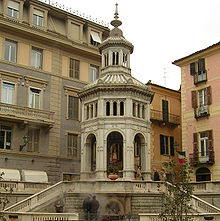Acqui Terme
| Acqui Terme | ||
|---|---|---|

|
|
|
| Country | Italy | |
| region | Piedmont | |
| province | Alessandria (AL) | |
| Coordinates | 44 ° 41 ′ N , 8 ° 28 ′ E | |
| height | 156 m slm | |
| surface | 33.42 km² | |
| Residents | 19,732 (Dec. 31, 2019) | |
| Population density | 590 inhabitants / km² | |
| Factions | Lussito, Ovrano, Moirano | |
| Post Code | 15011 | |
| prefix | 0144 | |
| ISTAT number | 006001 | |
| Popular name | Acquesi | |
| Patron saint | San Guido | |
| Website | Acqui Terme | |
Acqui Terme ( Piedmontese Äich ) is a town with 19,732 (as of December 31, 2019) inhabitants in the province of Alessandria (AL), Piedmont region in Italy . It is known for its hot sulphurous thermal springs , one of which is in the city center.
geography
The city is located 34 kilometers southwest of the provincial capital Alessandria on the southeastern edge of Montferrat . The place is located on the right bank of the Bormida River .
The districts of Lussito , Ovrano and Moirano belong to Acqui Terme .
The neighboring municipalities are Alice Bel Colle , Castel Rocchero , Cavatore , Grognardo , Melazzo , Montabone , Ricaldone , Strevi , Terzo and Visone .
history
The current name of the city comes from Latin , in Roman times the city was called Aquae Statiellae . It was founded before, by a Ligurian tribe under the name Carystum . In 173 BC It was destroyed by Marcus Popillius Laenas and re-established under the name Aquae Statiellae . After the construction of the Roman road Aemilia Scaurii , the city gained economic importance. Until the end of the Roman Empire, it was also known for its thermal springs, which were counted among the best in the empire.
The diocese of Acqui , which still exists today, was founded at the end of the 4th or beginning of the 5th century.
After the end of Roman rule, Acqui began to decline. The city was conquered by the Longobards and became part of the Principality of Asti . Under episcopal rule from 978 a city wall was built and construction of the cathedral began.
In 1135 the city gained independence and came under the spotlight of the expansionist goals of the Princes of Ponzone and Montferrat. In the 12th century she became dependent on the latter in order to escape the rule of the rival neighboring city of Alessandria .
Culinary specialties
The municipality is approved for the cultivation and production of DOC wines of the Monferrato denomination . Furthermore, the DOCG wine Barbera d'Asti can be produced here.
Attractions
The construction of the Cathedral of Santa Maria Assunta began in 989 and was consecrated in 1067. It houses a baroque altar and a triptych of the Madonna del Monserrato .
The castle ( Castello dei Paleologi ), now an archaeological museum, originally dates back to 1056. In the 15th century it was rebuilt by Guglielmo VII.
The Chiesa dell'Addolorata church was founded by the Lombards in the 7th century and heavily modified in the 18th century. The nave and the Romanesque bell tower have been preserved from the original construction.
A thermal spring in the center of the city in the shape of an octagon from 1879, called La Bollente , provides thermal water with a temperature of approx. 75 ° C.
Population development

sons and daughters of the town
- Luigi Crosio (1834-1915), painter
- Pietro Orsi (1863–1946), modern historian and fascist politician
- Camilla Ravera (1889–1988), politician, 1982 became the first woman to be appointed senator for life
- Giorgio Balladore Pallieri (1905–1980), international lawyer
- Luigi Raimondi (1912–1975), cardinal of the Roman Catholic Church
- Alberto Pozzetti (1914–2002), documentary filmmaker and screenwriter
- Riccardo Ghione (1922–2003), filmmaker
- Giulietto Chiesa (1940–2020), journalist and politician
- Cristiano Caratti (* 1970), tennis player
- Pierdomenico Baccalario (* 1974), children's and youth author
Web links
- City of Acqui Terme (Italian)
- Information at piemonteweb.it (Italian)
- Information at comuni-italiani.it (Italian)
Individual evidence
- ↑ Statistiche demografiche ISTAT. Monthly population statistics of the Istituto Nazionale di Statistica , as of December 31 of 2019.
- ↑ Production regulations and description of Monferrato DOC , (Italian), on quattrocalici.it
- ↑ Production regulations and description of Barbera d'Asti DOCG ( Memento of March 4, 2016 in the Internet Archive ) (Italian, PDF)



